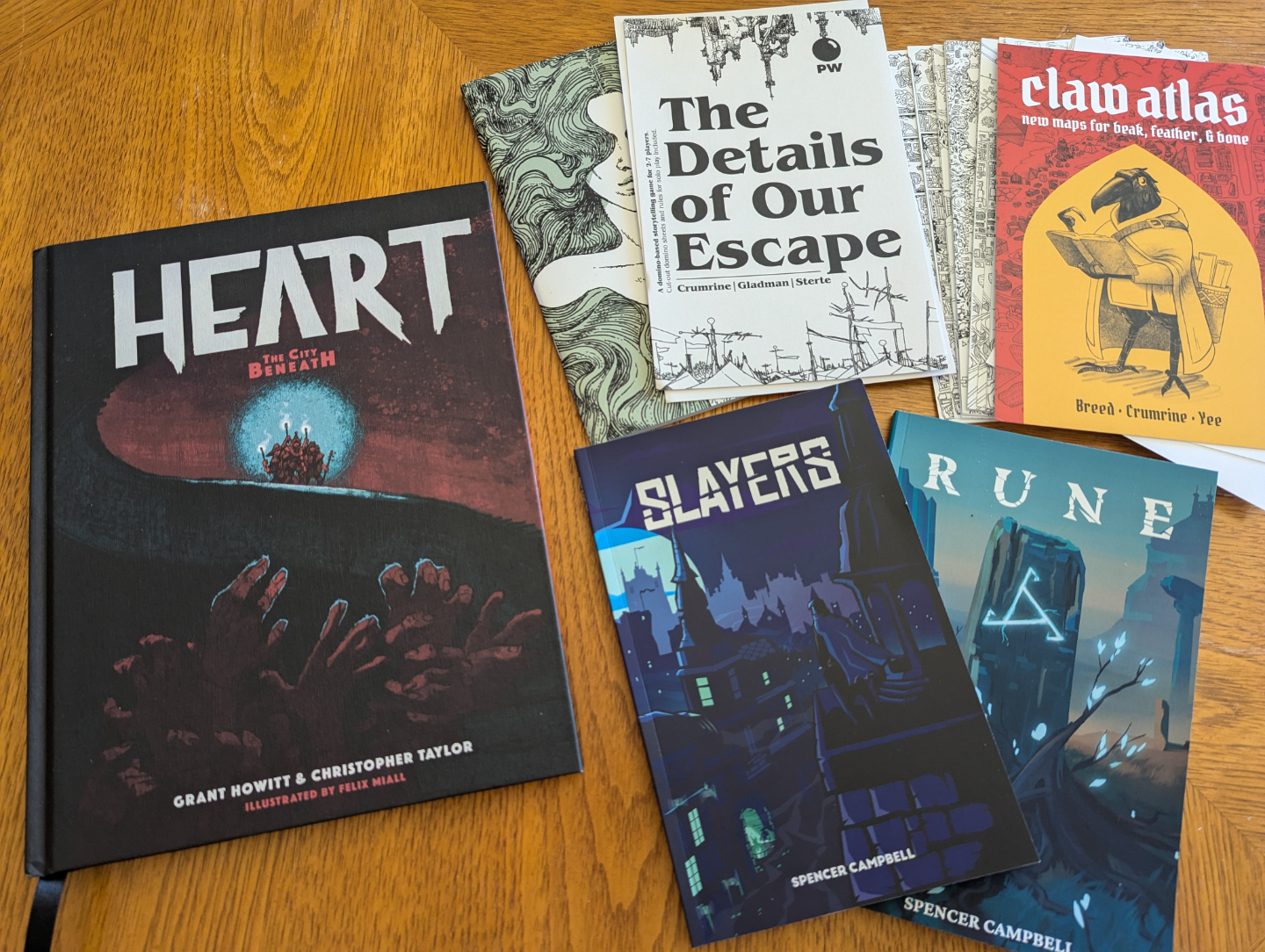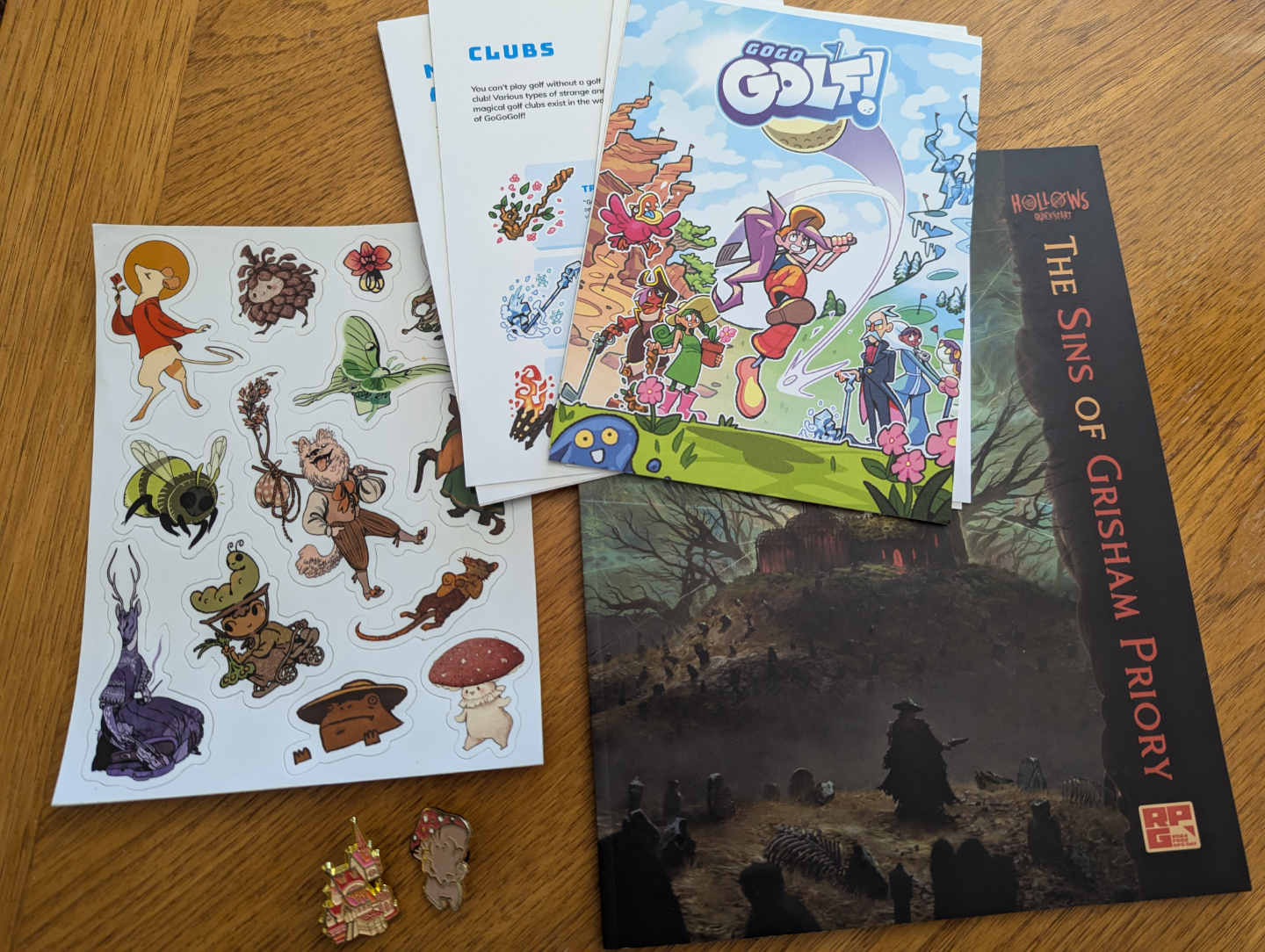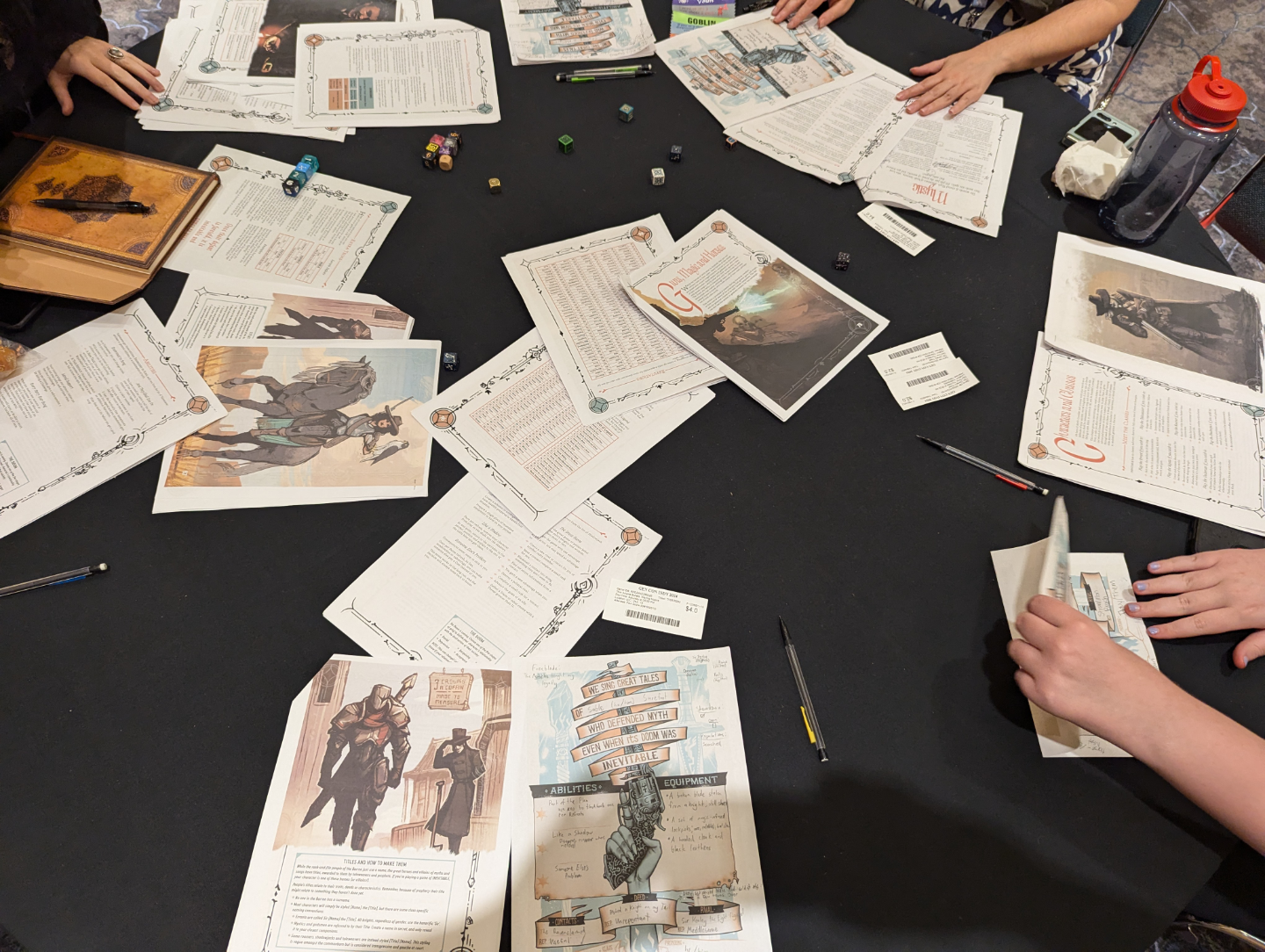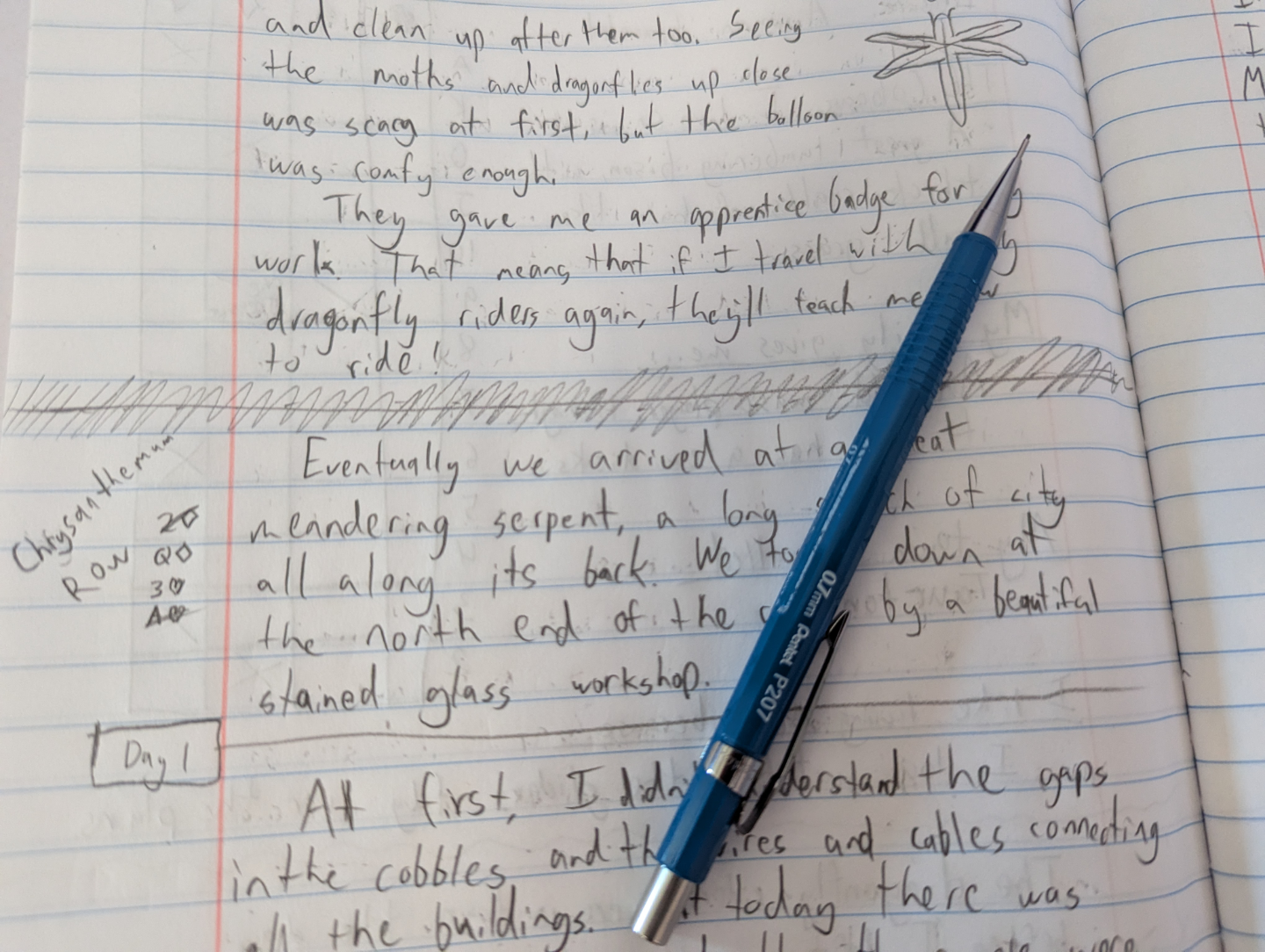
This past weekend I attended Gen Con, an enormous annual gaming convention with a history that goes all the way back to the early days of Dungeons and Dragons. It was a chance to explore more of the wider tabletop games space and play with a greater variety of folks.
Overall Impressions
It was my first time at Gen Con, so I attempted to pace myself with various game events, but I also underbooked myself a little bit. I spent a good amount of time wandering the convention center, which had massive spaces dedicated juggernauts of the tabletop scene like Magic: The Gathering, Warhammer, and Dungeons and Dragons.
But it also had an enormous variety of other interesting things to play. I focused the majority of my attention on role-playing games, with a couple of general ideas in mind:
- I was looking forward to was spending more time as a player in some of the TTRPGs that I’ve only ever run or read or seen played by others. Character development is one of my weaknesses as a GM, so it can be helpful to spend time finding characters within a session.
- Sitting on the player side of the table also helps me better empathize with how players might experience these games, and gives me further context on how other GMs run them.
Overall, I had a good time, and I mostly enjoyed the events I attended. Of course, while the gaming sessions were my main reason to be there, there was also an enormous show floor with a ton of stuff to buy. So, regrettably, I would like to briefly talk about "the haul".
What I Bought (Sorry)
I was traveling light, so I did my best to restrain myself. It was nice just to see so many little indie things I care about out on a big show floor with so many people, and so many that were new to me as well.

Heart: The City Beneath
Heart is a followup of sorts to Spire: The City Must Fall (more on that later) that takes a more overtly horror approach to the setting of Spire, elaborating on the sprawling undercity beneath and the eldritch things within. It’s the system used by Friends at the Table's horror/weird-west season Sangfielle, and it’s a game I’ve been interested in running for a while ever since the brief Spire mini-campaign I ran a couple years back. I’ve been flipping through Heart already and I’m excited to give it a closer read.
Rune
Spencer Campbell (aka Gila Games) uses a mechanical palette for his games that's fairly new to me. Rune is a solo “soulslike” RPG that tries to use a grid-based combat resolution system to evoke the experience and tension of fighting bosses in a From Software video game. At a glance, Rune's combat looks a bit to me like running a D&D encounter against yourself. It sounds strange, and I don't know if I think it'll work; that's why I'm looking forward to trying it out.
Slayers
From the same creator, Slayers is a rules-light game about a group of monster hunters in a haunted, endless city. It has stylish art, it's endearingly condensed and flavorful, and it has interesting ideas about character differentiation. I’ve yet to dig into it deeply, but so far it seems distinctive.
The Details of Our Escape
The Details of Our Escape is a recently-kickstarted game from Possible Worlds games about a caravan of travelers in search of a new home. Its monochromatic art style is simultaneously spare and lush, and it uses a system based on dominos to unravel its story.
Claw Atlas
Possible Worlds has a great number of interesting games, but I’ve played only a couple; one of these still-unplayed titles is Beak, Feather & Bone, a game about labeling the map of a city while representing the various cohorts of birdfolk that live and work within it. Claw Atlas provides additional maps to use and a few more factions and mechanical twists. More motivation to find a good time to play it!
Pack-ins and Extras

A few other things that I came home with:
- The Hollows Quickstart — I’ve not yet flipped through this much; it’s one of the newest games from prolific design duo Grant Howitt and Christopher Taylor (Heart, Spire, many more). It touts a unique approach to combat and positioning that promises to make for tactical and dramatic encounters. I’m curious to flip through it and see how it works.
- Gogo Golf — a pack-in from Possible Worlds games. It's a cute little game about fighting monsters with magic golf clubs; the illustrations of golf clubs has immense “drawing custom keyblade designs as a child” energy and I love it.
- I also bought some stickers and pins from Possum Creek games, which packs their games with tons of gorgeous and whimsical art, particularly their most recent major release, Yazeba’s Bed & Breakfast (we’ll get back to that).
What I Played
Avatar Legends RPG
Avatar Legends, published by Magpie Games, is the official TTRPG for the beloved Avatar TV shows. Early last year, I ran the system for a couple of months with my regular RPG group. I found it to be surprising and unique, but unwieldy. It went to great effort to make its combat encounters feel like dramatic martial arts showdowns, but some of the complexity introduced in the endeavor felt extraneous or prone to friction.
Getting to play it at someone else's table, it was nice to see someone else running it. Ultimately, it still managed to be unwieldy despite their careful tracking of characters. That said, there were endearing and exciting moments that fell from the way the combat encounters operate. I'm still on the fence about a lot of the system, but I'm more excited now to try playing with it again in the future.
For The Queen
For The Queen is a card-based story game by Alex Roberts. It's about a queen traveling somewhere to broker an alliance, and the retinue of companions who defend her on her journey. It's very straightforward, composed almost entirely of story prompts on cards.
I played it with a hastily-assembled group of folks at one end of a table in the big gaming hall. The game is simple and elegant, a series of cards with simple prompts. That said, the event was organized so that we were simply handed the game and the instructions, and the facilitator left as soon as we’d talked over the rules; it was a bit of a challenge at first to build a rapport with the table while also developing interesting characters, and I found that it fell a little flat for me. The game itself would likely have been much stronger with a more familiar table, or a little more time to get familiar with each others' ideas.
Pacing in PbtA (Panel)
The only panel I attended was a panel hosted by Magpie Games, publisher of the Avatar Legends RPG, on how best to pace games in the Powered by the Apocalypse system. It was a relatively small room and the panelists’ advice was pretty heavily tailored towards convention play and professional GMing. Their advice broadly focused on a grab bag of tips to keep campaigns and sessions focused and rewarding.
I found myself surprisingly underwhelmed by this panel, in large part because its focus veered away from the realities of my own tables. But more than that, I think it’s possible that — after hundreds of hours of reading, prepping, and running these systems myself — I’ve already developed my own approaches and strategies for running PbtA games that works for me and my groups. While I hoped the panel would be more enlightening, it still proved to be a good opportunity for reflection. I certainly don’t have it all figured out (and I do think that the advice on offer was generally reasonable and useful); it’s a reminder that player groups and contexts vary widely, and the best approaches to GMing tend to be synthesized from a broad range of advice, experience, and player input.
Spire: The City Must Fall
Spire is a game about dark elf revolutionaries in a towering multi-leveled fantasy city controlled by high elf colonizers. It uses a dice pool system and has character and setting concepts that are spectacularly strange and evocative.
The session of Spire that I played was part of a multi-table format, in which each of the 6 tables was participating in an interconnected story. Each table was tasked with assassinating a different member of the high council, while protecting the one remaining council member whom the resistance could control. It was a wonderfully chaotic time, and the GM at my table was great with spotlight management, while the table was great with following each others shenanigans as we scattered about the room, hastily cobbling together an assassination. Meanwhile, the wandering "good" council member (portrayed by co-designer of the game Grant Howitt) stumbled from table to table carelessly endangering himself. Grant was costumed, theatrical, and goofy, doing bits of physical comedy according to the fiction regardless of where he was in the room.
The format definitely worked best when the scaffolding of the scenario wasn't too heavily stressed. There was a degree of foregone conclusion (you might not really want the tables to be able to undermine each other by failing the mission), so some dramatic tension was sacrificed in order to keep the scenario more architected and on track. Despite this, I thought it was a memorable experience, and it was fun to see it use the format of the convention to some distinctive effect. The GM running my table ran with our ideas and shook things up in fun ways when consequences reared.
Inevitable
Inevitable is a "Doomed Arthurian Western RPG", a game about cowboys, knights, and mages fighting to resist an inevitable apocalypse. Its system is a curious mishmash of Forged in the Dark ideas with bespoke rules for "showdowns" with noteworthy antagonists. In regular play, characters lean on their abilities, special equipment, and the “reputations” that they’ve earned from friends, rivals, and significant deeds. When resolving an action with a dice roll, all of these elements are negotiated into or out of play according to relevance to build the dice pool.
Inevitable was easily the highlight of the convention for me. The GM told us up front that it was their first time running the game (though they had read it closely and prepared, of course). Two other players at the table were friends with the GM, so it sometimes felt a bit like joining in with a pre-existing table of friends, mostly in a good way. It was the only game at the convention where I built a character entirely from scratch at the beginning, choosing the backstory prompts and enjoying the delightful intersections between our characters (my scoundrel had disgraced and embarrassed a knight who happened to be the mystic's trusted mentor,only made more complicated by the fact that the mystic had hired me to join the quest).

The GM was theatrical, leaning into the melodrama, occasionally with a little more intensity than I really needed. But more importantly, they did a wonderful job weaving threads from character creation together into a complex personal web, and sharing the spotlight appropriately. When two players (the ones who knew each other) turned on one another in a clash of ambition, duty, and heartbreak, the scenario spiraled into a frantic PvP exchange that quickly roped in the rest of us, to which the GM adapted admirably. We tied it off by fast-forwarding to the final apocalyptic encounter and watching our characters give up everything in a hopeless attempt to save the world. It was incredible fun, a table that I mostly had good chemistry with, and I was really delighted to have played a part.
Yazeba’s Bed & Breakfast
Yazeba’s Bed & Breakfast is a charming game from Possum Creek Games about a magical Bed & Breakfast owned by a witch who gave up her heart, and the variety of strange and wonderful folks who stay there. I’ve played and even facilitated the game before, but this is the first time I got to see it in a particular light. It’s designed around chapters, which are something like short stories for TTRPG sessions; each one sets up a scenario, explains which characters are involved, and then employs one of four different mechanical structures to lead the scene towards a conclusion. As chapters conclude, things change in the B&B, characters continue on their personal journeys, and new characters arrive.
At this session, we played a version of the B&B that had already been inhabited by a number of player groups, and whose characters had all sorts of changes written onto their sheets, big and small. It was delightful to look at them and come to understand what their journey had been, and then play a little part in continuing it. I hadn't really seen it in this light before, but this is one of the remarkable and unique things about Yazeba's: it can tell a story across groups without feeling like it leaves folks out.
Bonus: OLDHOME
Periodically throughout the convention, when I had an hour or so to kill, I picked away at a game of OLDHOME: Children Chasing Giants by Takuma Okada in a little composition notebook I brought with me. I find solo journaling RPGs to be very rewarding, but I rarely manage to set aside time for them. The breaks between events and convention wandering were a great way to squeeze in a little time. OLDHOME is a pastoral fantasy story about children who go on journeys to find the owners of lost items, in a world of cities and towns built on the backs of enormous colossi; it’s technically designed for multiple players but has rules for solo play.
It was admittedly a little confusing to parse the intentions of the rules at first, but I eventually found its rhythm. So far, I’m enjoying the adventure and the exercise of inventing new places on the backs of giant beasts. My intrepid adventurer has journeyed to a long and narrow city stretched along the back of a giant snake (with special cables and supports that keep the buildings from falling over when the snake swallows a meal) and a small farming town under a great glass dome on the back of a giant stingray, where children play games in the refracted light patterns that dance across the fields.

Future Adventures
There are a few things I wish I'd done differently this time around, that I hope to learn from:
- I should have signed up for more events, and checked the events list much sooner than I did. Some of the things I was interested in sold out well before I found them.
- I should also have signed up for a miniatures game of some sort, especially since there were a number of beginner-friendly events; it's a massive corner of the RPG hobby that I really haven't had any experience with at all. I don't think I'm ready to dive into wargaming in general, but it would be fun to dip a toe.
- This is maybe an obvious one, but I'd love to go with friends next time; it got a bit lonely to be there on my own!
- I met some lovely folks here and there, and I think I should have asked if people were interested in exchanging socials. I was nervous about making a lapse in etiquette, so I mostly just said goodbye and moved on to other things; it might have been nice to be able to keep up with anyone I met there.
And in general, for the future, I think I'd like to try running convention games! Playing games with a few different GMs in different contexts gave me some confidence that there's room for my style and skill level of GMing in settings like that, and that the experience would be useful and gratifying. It'll be a challenge, but it's one I think I'm finally up to.